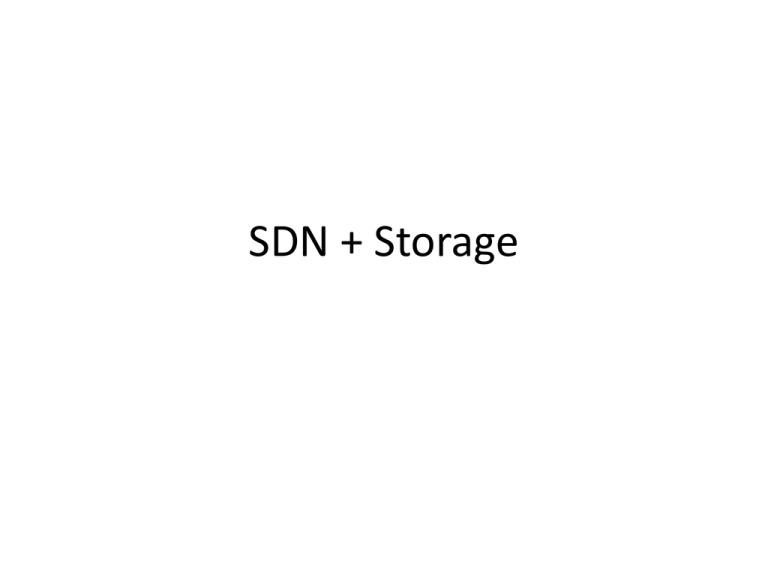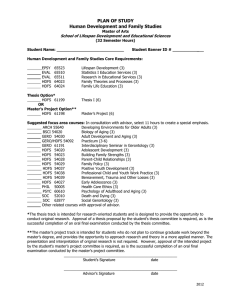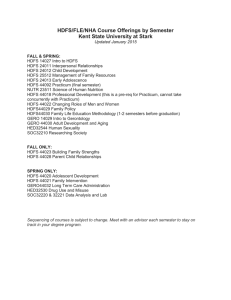SDN + Storage
advertisement

SDN + Storage
Outline
• Measurement of storage traffic
• Network aware placement
• Control of resources
• SDN + Resource allocation
– Predicting Resources utilization
– Bring it all together
HDFS Storage Patters
– Maps reads from HDFS
• Local read versus Non-local read
• Rack locality or not
Locality!!!
80%
HDFS Storage Patters
– Maps reads from HDFS
• Local read versus Non-local read
• Rack locality or not
Cross-rack
Traffic
80%
HDFS Storage Patters
– Reducers writes to HDFS
• 3 copies of file written to HDFS
• 2 rack local and 1 non-rack local
• Fault tolerance and good performance
THERE MUST BE
CROSS RACK
TRAFFIC
Ideal Goal: Minimize
Congestion
Real Life Traces
• Analyze Facebook traces:
– 33% of time spent in network
– Network links are highly utilized; why?
– Determine cause of network traffic
1. Job output
2. Job input
3. Pre-processing
Current Ways
To Improve HDFS Transfers
• Change Network Paths
– Hedera, MicroTE, C-thru, Helios
• Change Network Rates
– Orchestra, D3
• Increase Network Capacity
– VL2, Portland (Fat-Tree)
The case for Flexible Endpoints
• Traffic Matrix limits benefits
– of techniques that change paths
– of network rates
• Ability to Change Matrix is important
90%
20%
80%
90%
Flexible Endpoints in HDFS
• Recall: Constraint placed by HDFS
– 3 replicas
– 2 fault domains
– Doesn’t matter where as long as constraints are
met
• The source of transfer is fixed!
– However destination, location of 3 replicas is not
fixed
Sinbad
• Determine placement for block replica
– Place replicas to avoid hotspots
– Constraints:
• 3 copies
• Spread across 2 fault domains
• Benefits
– Faster writes:
– Faster transfers
Sinbad: Ideal Algorithm
• Input:
– Blocks of diff size
– Links of diff capacity
• Objective:
– Minimize write time (transfer time)
• Challenges: Lack of future knowledge
– Location & duration of hotspots
– Size and arrival times of new replicas
Sinbad Heuristic
• Assumptions
– Link utilizations are stable
• True for 5-10 seconds
– All block have same size
• Fixed-size large blocks
• Heuristic:
– Pick least-loaded link/path
– Send block from file with least amount to send
Sinbad Architecture
• Recall: original DFS is master-slave
architecture
• Sinbad has similar
Sinbad
• Determine placement for block replica
– Place replicas to avoid hotspots
– Constraints:
• 3 copies
• Spread across 2 fault domains
• Benefits
– Faster writes:
– Faster transfers
Orchestrating the Entire Cluster
• How to control Compute, Network, Storage?
• Challenges from SinBAD
– How to determine future replica demands?
• You can’t control job arrival
• You can control task scheduling
• If you predict job characteristics you can determine future
– How to determines future hot spots?
• Control all network traffic (SDN)
• Use future
Ideal Centralized Entity
• Controls:
– Storage, CPU, N/W
• Determines:
– Which task to run
– Where to run the task
– When to start Network transfer
• What rate to transfer at
• Which network path
Predicting Job Characteristics
• To predict resources that a job needs to
complete, what do you need?
Predicting Job Characteristics
– Job’s DAG (job’s traces history)
– Computations time for each node
– Data transfer size between nodes
– Transfer time between nodes
Things you absolutely know!
• Input data
– Size of input data
– Location of all replicas
– Split of input data
200
GB
3
Mappers
HDFS
Map
Map
Map
• Job’s D.A.G
– # of Map
– # of Reduce
2
Reducers
Reduce
Reduce
HDFS
Approaches to Prediction:
Input/intermediate/Output Data
• Assumption:
– Map & Reduce run same code over and over
– Code gives the same ratio of reduction
• E.g. 50% reduction from Map to intermediate
• E.g. 90% reduction from intermediate to output
Map
HDFS
200
GB
Map
Map
• Implications:
100
GB
– Given size of input, you can determine size of
future transfers
• Problems:
– Not always true!!!
Reduce
Reduce
HDFS
10
GB
Approaches to Prediction:
Task Run Time
• Assumption:
– Task is dominated by reading input
– Time to run a task is essentially time to read
input
• If Local: Time to read from Disk
• If non-local: Time to read across Network
Map
HDFS
200
GB
Map
Map
• Implication:
100
GB
– If you can model read time you can determine
task run time
• Problems:
– How do you model disk I/O?
– How do you model I/O interrupt contention?
Reduce
Reduce
HDFS
10
GB
Predict Job Runs
• Given:
– Prediction of tasks, transfers, and of Dag
• Can you predict job completion time?
– How do you account for interleaving between
jobs?
– How do you determine optimal # of slots?
– How do you determine optimal network
bandwidth?
1
0 sec
Reduce
23
30
10 sec
HDFS
2
2
10
GB
3
Map
8
1
Map
HDFS
2
100
GB
Reduce
Map
200
GB
23
3
40 sec
• Really easy right?
– But what happens if the network only has 2 slots
• You can’t run map in parallel
Reduce
23
2
30
3 sec 13 sec
HDFS
2
10
GB
3
Map
8
Reduce
Map
1
1
0 sec
100
GB
Map
HDFS
200
GB
2
23
3
33 sec
• Which tasks to run in which order?
• How many slots to assign?
Approaches to Prediction Job Run
Times
• Assumption:
– Job Runtime Function (# slots)
• Implication:
– Given N slots, I can predict completion time
• Jockey Approach [EuroSys’10]
–
–
–
–
Track job progress: fraction of completed tasks
Build a map of [{% done + # of slots} time to complete]
Use simulator to build map
Iterate through all possible combination of # of slots and %done.
• Problems:
– Ignores network transfers: Network congestion
– Cross job contention on server can impact completion time
– Not all tasks are equal: # of tasks done isn’t a good representation of progress
Open Questions
• What about background traffic?
– Control messages
– Other bulk transfer
• What about unexpected events?
– Failures?
– Loss of data?
• What about protocol inefficiencies?
– Hadoop scheduling
– TCP inefficiencies
– Server scheduling



